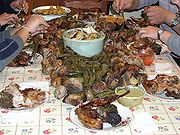
Huatia
Encyclopedia

Peru
Peru , officially the Republic of Peru , is a country in western South America. It is bordered on the north by Ecuador and Colombia, on the east by Brazil, on the southeast by Bolivia, on the south by Chile, and on the west by the Pacific Ocean....
vian earthen oven
Earth oven
An earth oven or cooking pit is one of the most simple and long-used cooking structures . At its simplest, an earth oven is simply a pit in the ground used to trap heat and bake, smoke, or steam food...
which dates back to the days of the Inca Empire
Inca Empire
The Inca Empire, or Inka Empire , was the largest empire in pre-Columbian America. The administrative, political and military center of the empire was located in Cusco in modern-day Peru. The Inca civilization arose from the highlands of Peru sometime in the early 13th century...
. A banquet prepared with this sort of oven is known as a Pachamanca
Pachamanca
Pachamanca is a traditional Peruvian dish based on the baking, with the aid of hot stones , of lamb, mutton, pork, chicken or guinea pig, marinated in spices...
. This type of oven is commonly associated with the peasants in the Cuzco region in the Andes
Andes
The Andes is the world's longest continental mountain range. It is a continual range of highlands along the western coast of South America. This range is about long, about to wide , and of an average height of about .Along its length, the Andes is split into several ranges, which are separated...
.
Although the term is often used simply to refer to any simple dirt cooking pit, this is not considered the "proper" way to build a huatia. The most
traditional way to build the huatia (although perhaps not the most common today) is to carefully construct a dome or pyramid from rocks over a dirt pit using nothing but gravity to hold the dome together. This dome/pyramid must have an opening in which to place other rocks, kindling, and the food to be cooked. A fire is built inside (special rocks such as volcanic rocks must be selected which can resist the heat) until the rocks become sufficiently heated. Once the food (meat and potatoes most often in addition to herbs) is inside the dome/pyramid is allowed to collapse, either by the action of the heat or by manual intervention, to bury the food. It is then left to cook for many hours soaking up flavors from the surrounding soil. Although any fire in the pit is extinguished the heat remains for a long time. Eventually the food is dug out of the ground and served.
As a practical matter the Pachamanca is today served in many parts of Peru
Peru
Peru , officially the Republic of Peru , is a country in western South America. It is bordered on the north by Ecuador and Colombia, on the east by Brazil, on the southeast by Bolivia, on the south by Chile, and on the west by the Pacific Ocean....
even though the tradition of the huatia is changing (i.e. to simplify the cooking process). It can be debated whether the elaborate construction process of the traditional huatia really adds anything essential to the actual flavor of the food as opposed to simply burying the food. It is, nevertheless, part of the Peruvian heritage.

